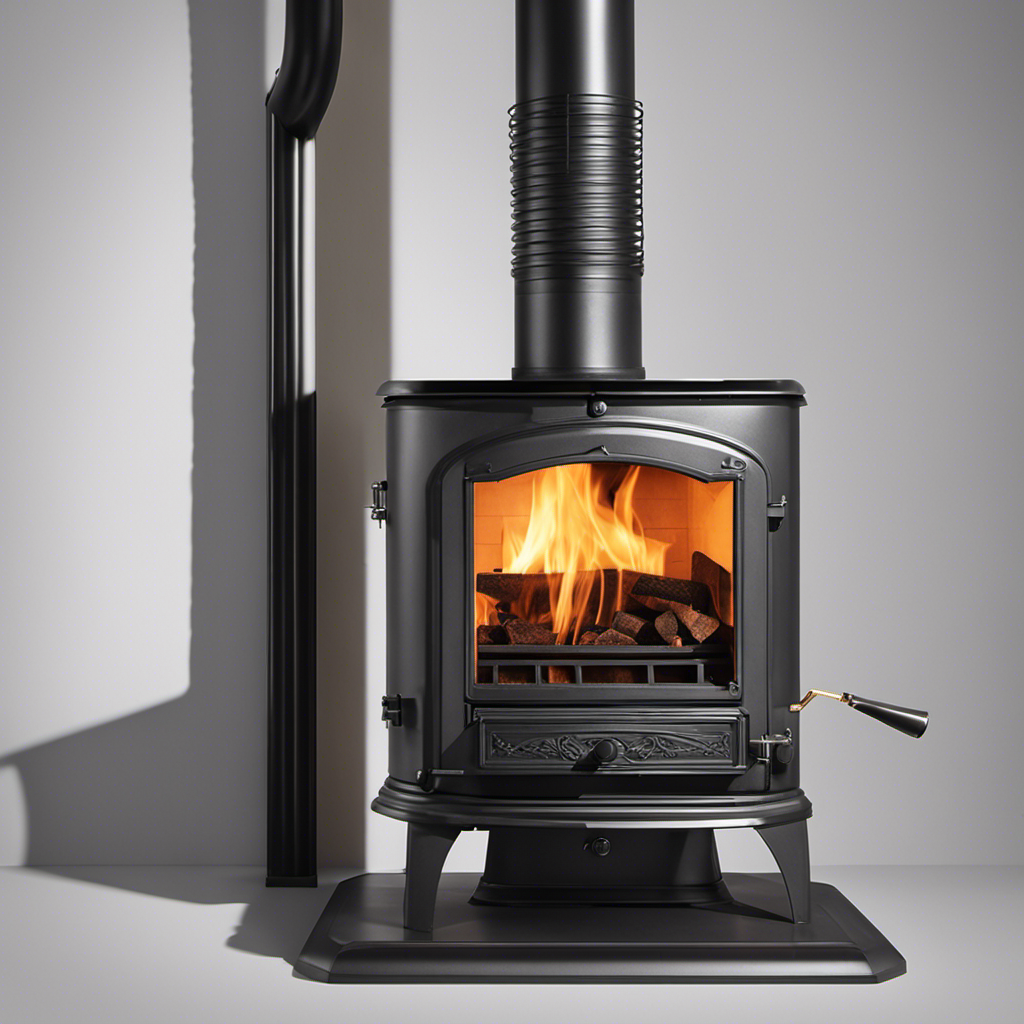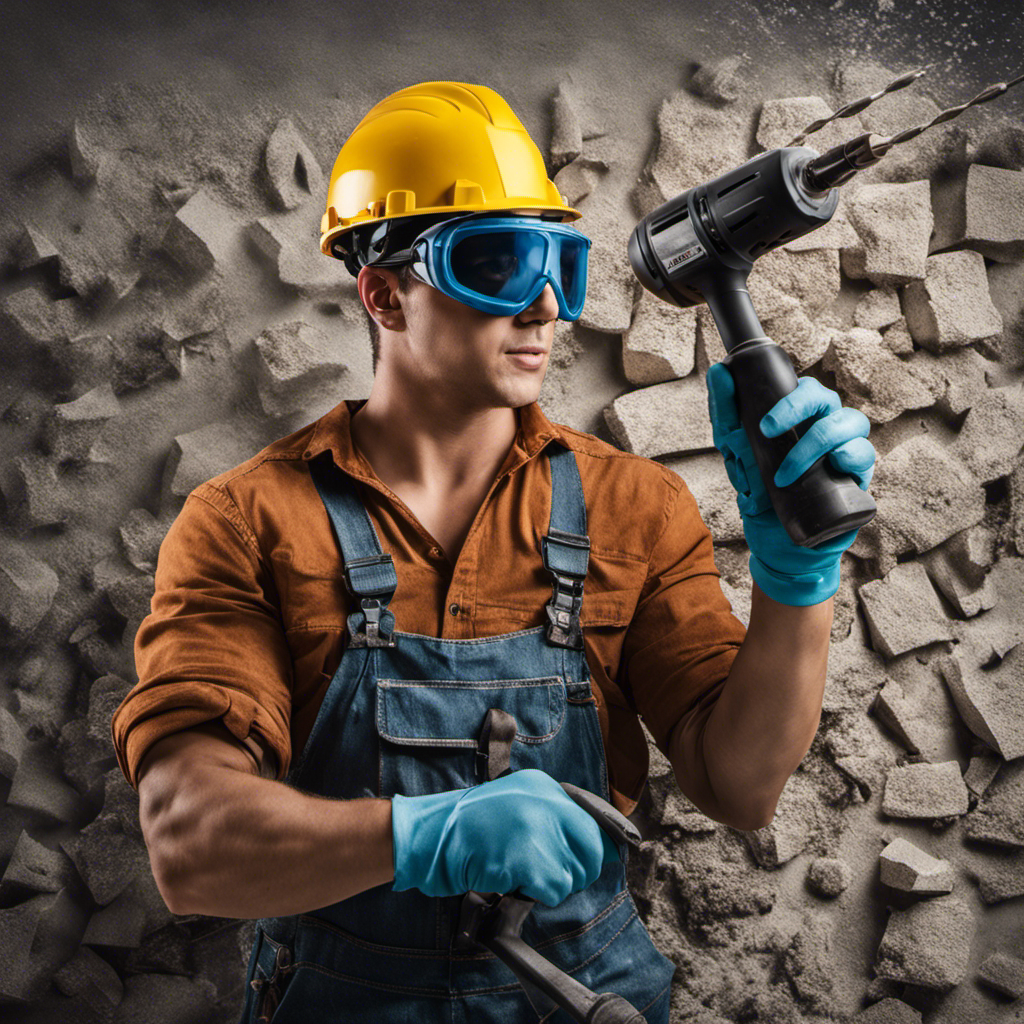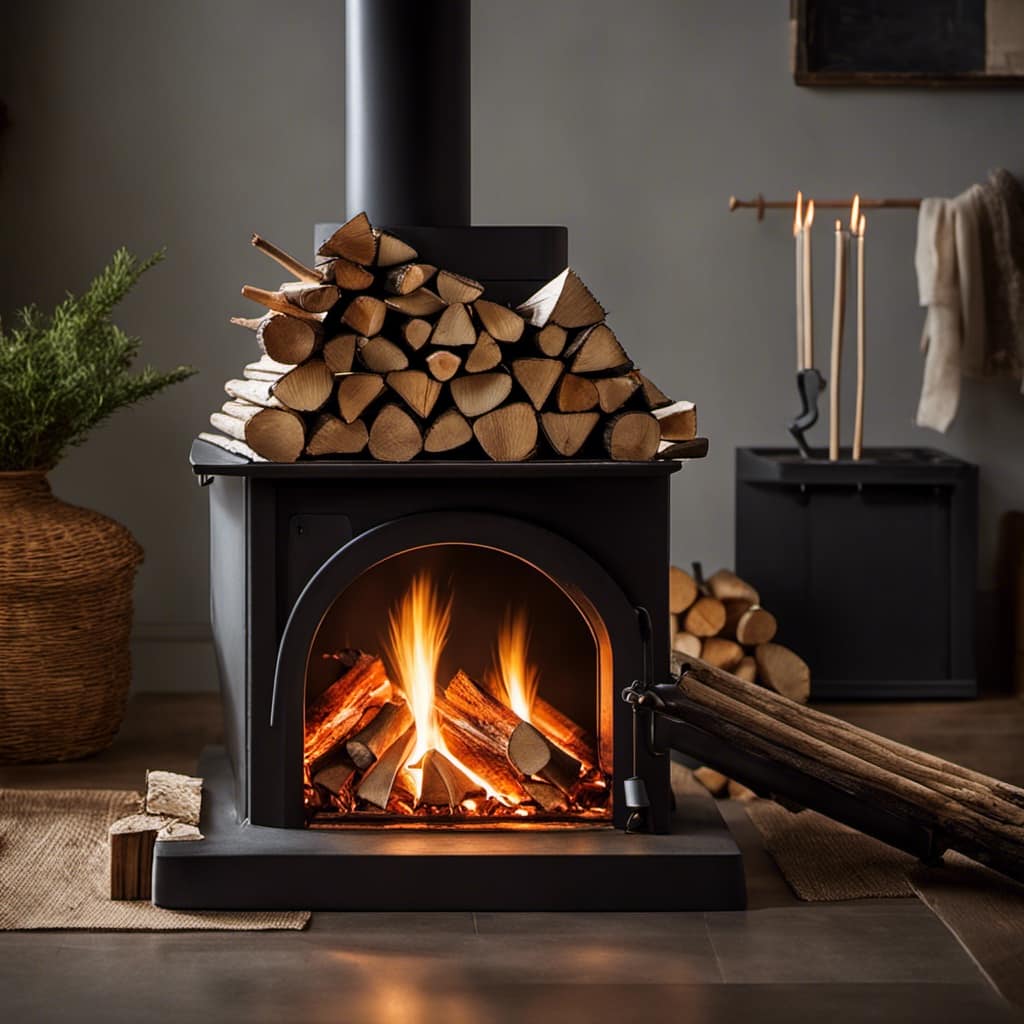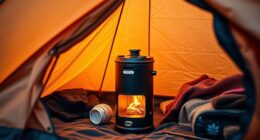I have always been attracted to the cozy atmosphere and warmth that a wood stove adds to a home.
But when it came time to install a wood stove pipe and chimney, I was a bit overwhelmed. Thankfully, I’ve learned the ropes and now I’m here to share my step-by-step guide with you.
In this article, I’ll walk you through choosing the right materials, measuring and cutting the stove pipe, installing the chimney, ensuring proper ventilation, and maintaining the system for optimal performance.
Let’s get started!
Key Takeaways
- Choose a durable material for the stove pipe, such as stainless steel.
- Consider using insulating chimney liners to improve efficiency.
- Insulate the chimney to prevent heat loss and condensation.
- Ensure proper ventilation by regularly cleaning the chimney and checking for blockages.
Choosing the Right Stove Pipe and Chimney Materials
I need to choose the right stove pipe and chimney materials for my wood stove installation. When it comes to the stove pipe, it’s essential to select a material that’s durable and can withstand high temperatures. Stainless steel is a popular choice due to its strength and resistance to corrosion.
Additionally, it’s crucial to insulate the chimney to prevent heat loss and improve efficiency. Insulating chimney liners are available, which can help retain heat and reduce the risk of condensation.
Another important consideration is the proper chimney height. The height of the chimney should be sufficient to create a strong draft and prevent smoke from entering the living space. It’s recommended to consult local building codes to determine the minimum required chimney height for your area.
Measuring and Cutting the Stove Pipe
To ensure a precise fit, measure and cut the stove pipe according to the specific dimensions provided in the installation manual. Measuring accuracy and using proper cutting techniques are crucial for a successful installation. Here are some steps to follow:
-
Gather the necessary tools: a tape measure, marker, and a pipe cutter or reciprocating saw.
-
Begin by measuring the length needed for the stove pipe. Use the tape measure to accurately determine the distance between the stove and the chimney.
-
Mark the measured length on the stove pipe using a marker.
-
Use a pipe cutter or reciprocating saw to cut the pipe along the marked line. Ensure a smooth and clean cut.
It’s important to note that the accuracy of your measurements and the precision of your cuts will directly affect the fit and functionality of the stove pipe. Take your time and double-check your measurements before cutting to avoid any errors.
To further emphasize the importance of measuring accuracy and cutting techniques, here’s a table highlighting the key points:
| Measuring Accuracy | Cutting Techniques |
|---|---|
| Use a tape measure for precise measurements | Utilize a pipe cutter or reciprocating saw |
| Double-check measurements before cutting | Ensure a smooth and clean cut |
| Follow the specific dimensions provided in the installation manual | Take your time and avoid rushing the process |
Installing the Stove Pipe and Chimney
After measuring and cutting the stove pipe, I carefully installed it onto the chimney using the provided instructions. The next step is to ensure safety precautions are taken during the installation process.
Here’s a step-by-step guide to help you install your wood stove pipe and chimney correctly:
-
Begin by wearing protective gear, such as gloves and safety goggles, to prevent any injuries during the installation.
-
Attach the stove pipe securely to the wood stove using screws or clamps, ensuring a tight connection.
-
Place the stove pipe onto the chimney, making sure it fits snugly. Use high-temperature sealant to secure the connection and prevent any leaks.
Troubleshooting common issues:
-
If you notice smoke leaking from the joints, check for loose connections and tighten them accordingly.
-
If there’s a backdraft, ensure that the chimney is properly insulated and the damper is open.
-
In case of excessive creosote buildup, consider cleaning the chimney regularly to prevent any potential fire hazards.
Ensuring Proper Ventilation for the Wood Stove
The key to ensuring proper ventilation for the wood stove is to regularly clean the chimney and check for any blockages. Proper ventilation is crucial for the safe and efficient operation of a wood stove. Common ventilation issues can include poor draft, smoke backflow, and inadequate air circulation. To troubleshoot ventilation problems, start by cleaning the chimney thoroughly. Remove any creosote buildup or debris that may be obstructing the airflow. Next, check for any blockages in the stovepipe and ensure that it is properly connected and sealed. Additionally, consider installing a damper to regulate the airflow and improve draft. Finally, make sure the room where the wood stove is located has adequate ventilation, such as open windows or a fresh air intake. Regular maintenance and attention to these ventilation issues will help ensure the safe and effective operation of your wood stove.
| Common Ventilation Issues | Troubleshooting Ventilation Problems |
|---|---|
| Poor draft | Clean chimney thoroughly |
| Smoke backflow | Check for blockages in stovepipe |
| Inadequate air circulation | Install a damper |
| Ensure room has proper ventilation |
Maintaining and Cleaning the Stove Pipe and Chimney
I need to regularly clean out the stove pipe and chimney to ensure proper ventilation and prevent any potential blockages. Cleaning techniques are essential to maintain the efficiency and safety of your wood stove.
Here are some steps to help you clean your stove pipe and chimney effectively:
-
Gather the necessary tools: chimney brush, extension rods, goggles, gloves, and a dust mask.
-
Start by removing the stove pipe from the stove and clean it thoroughly using the brush and rods.
-
Inspect the chimney for any debris or creosote buildup. Use the brush and rods to clean the chimney from the top down.
-
Pay close attention to the chimney cap and flue liner, as these areas are prone to blockages.
-
After cleaning, carefully reassemble the stove pipe and ensure proper connections.
-
Lastly, dispose of the debris in a safe manner.
Frequently Asked Questions
Are There Any Specific Building Codes or Regulations That Need to Be Followed When Installing a Wood Stove Pipe and Chimney?
Building code requirements dictate the proper installation of a wood stove pipe and chimney. It is important to follow these regulations to ensure safety and compliance. Additionally, proper chimney pipe insulation is crucial for efficient operation.
Can I Use an Existing Chimney for My Wood Stove Installation, or Do I Need to Install a New One?
I can either use an existing chimney or install a new one for my wood stove. It depends on the condition and suitability of the existing chimney, as well as the specific requirements of the wood stove installation.
How Far Should the Stove Pipe Extend Above the Roofline for Proper Ventilation?
For proper ventilation and to comply with safety regulations, it is important to ensure that the stove pipe extends a sufficient distance above the roofline. This distance may vary depending on local building codes and the type of stove being installed.
Is It Necessary to Have a Chimney Cap Installed on the Top of the Chimney?
Yes, it is necessary to have a chimney cap installed on the top of the chimney. It helps prevent animals, debris, and rain from entering the chimney, while still allowing proper ventilation.
Can I Install a Wood Stove Pipe and Chimney Myself, or Should I Hire a Professional?
Installing a wood stove pipe and chimney myself has its pros and cons. While it can be a rewarding DIY project, hiring a professional ensures safety and expertise. It’s important to weigh the risks and benefits before making a decision.
Is Installing a Wood Stove Pipe and Chimney the Same Process as Installing a Buck Wood Stove?
Installing a buck wood stove requires a different process than installing a wood stove pipe and chimney. While both involve ensuring proper ventilation, connecting the stove to the pipe, and securing the chimney, the specific steps and materials may vary. It is essential to consult the manufacturer’s guidelines and consider professional assistance when installing a buck wood stove for optimal safety and performance.
Conclusion
In conclusion, installing a wood stove pipe and chimney requires careful consideration of the right materials, precise measurement and cutting, and proper installation techniques.
Ensuring proper ventilation is crucial for the safe operation of the wood stove. Regular maintenance and cleaning of the stove pipe and chimney are essential to prevent buildup and maintain efficiency.
By following these steps, you can enjoy the warmth and comfort of your wood stove while keeping your home safe and cozy.











